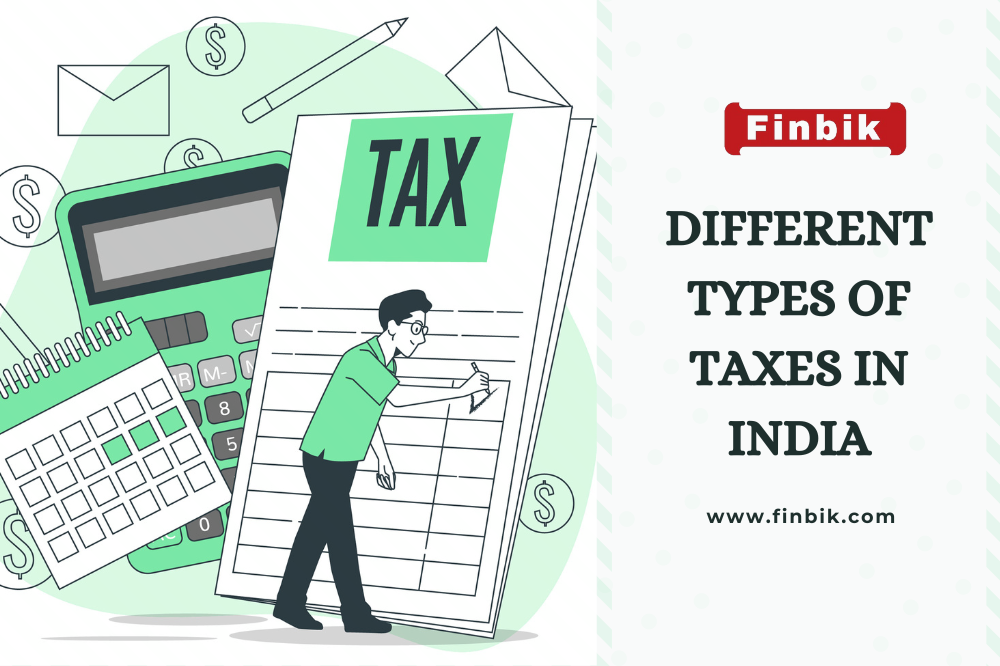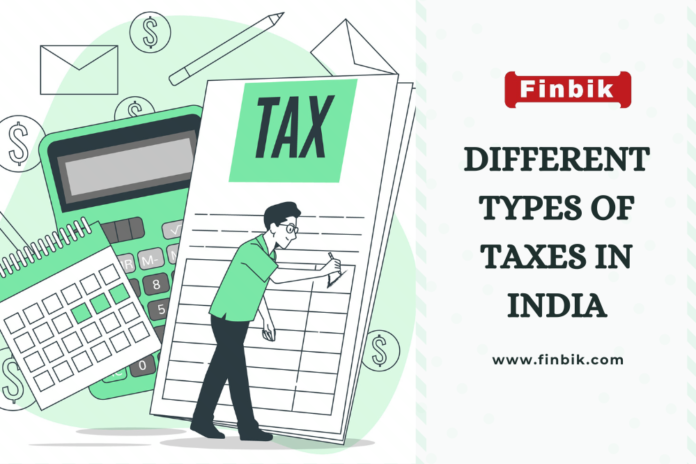Different types of taxes in India
What are the types of taxes in India?
What are the types of direct taxes in India?
What are the types of indirect taxes in India?
Different types of taxes in India

What are taxes?
In layman’s language, taxes are simply the financial amount we pay to the government in order to run the country smoothly. Taxes are the most vital and the largest income source of the government.
The tax structure comprises the central government, state governments, and local municipal bodies.
India has a three-tier federal structured tax system that is well defined.
What are the types of taxes in India?
There are two types of taxes that we pay to the government in India.
- Direct tax.
- Indirect tax
Taxation is majorly divided among the central government and the state government in our country.
What is a direct tax?
The tax that the government directly imposes on corporations and individuals. For individual taxpayers, the most prominent type of direct tax would be the income tax that is levied every financial year ( 1st April to 31st March). It accounts for almost 50% of the government’s revenue. It is mandatory for every individual to pay the income tax if the annual income is about the minimum exemption limit as per the Income-tax act,1961.
There are many tax benefits provided under the sections of this Act. The tax benefits are given according to your income tax slab.
What are the types of direct taxes in India?
- Income tax
- Capital gains tax
- Corporate tax
Let us look at this type of tax is one by one,
- Income tax
In India, there is a wide range of people who earn their living from different sources and ways. The government has put forth a structured tax policy to encompass all these individuals.
The income tax act segregates all the people into different tax slabs and levies tax percentages according to the slab.
The tax slab does not vary only upon your annual income but also your age.
After every financial year, during the central government budgeting session amendments are made to these tax slabs.
2. Capital gains tax
The income tax act divides the capital gains tax into two major categories.
- Short term capital gains tax
- Long term capital gains tax
The capital gains tax is levied only on the profits that are gained from selling a capital asset.
The long-term capital gains tax refers to the tax applied on any asset that is held by an individual for a long time. The tax levied depends upon the fluctuations in the value of that asset.
Short term capital gains tax refers to
- Cryptocurrency held for less than three years
- Stocks that are sold within 12 months of the purchase
- Debt mutual fund units sold within 36 months from the date of purchase
- Real estate property for gold is sold within 36 months from the date of purchase.
If the assets are sold after the aforementioned period then they will be counted under long-term capital gains. The tax is levied not on the total value but on the profit or loss gained on the asset. Indexation benefit may be bestowed upon you depending upon the type of asset you hold in the long term. Indexation helps you in reducing your tax liability.
3. Corporate tax
Corporate tax is levied upon people who file their income tax returns as a business or as a company. The slab rate also differs depending upon the turnover of the company in the given financial assessment year.
The tax slabs and the surcharges on each slab are also revised every year in the budgeting session of the central government.
To check it out:
https://www.incometax.gov.in/iec/foportal/help/company/return-applicable
What are the types of indirect taxes in India?
Indirect taxes have been the largest source of revenue for the Government of India for a very long time.
These are the taxes that we pay whenever we use any service or buy any product. They are called ‘indirect’ as they are not directly received by the government.
Some examples of these taxes which are operational are as follows:
a) Service Tax
This tax is paid whenever we use any service such as banking. The tax has not been used anymore as it has been replaced by the GST.
b) Indian Excise Duty
Indian excise duty, technically, does not exist in India except on a few items such as liquor and petroleum.
c) Customs Duty
Indian Excise duty or the customs duty tax. It is the tags that are levied on the goods that are imported into our country and its some cases exported from India.
d) Value Added Tax (VAT)
Since this tax was overlapping with the service tax many times it has been replaced with the goods and services tax.
e) Securities Transaction Tax (STT)
STT allows buyers of equity stocks long-term or short-term capital gains on their assets in the exchange.
f) Stamp Duty
The tax is levied when a piece of land or property is being transferred to another individual in their territory. It also serves as the legal proof of ownership of that asset or security.
g) Entertainment Tax
This tax is collected by the state from all the entertainment institutions such as parks, theaters, movies, sports, etc
h) Goods and services tax
In the complicated tax structure of India, there were many occurrences where two or more taxes would overlap with each other and the citizens would pay more tax for the same goods, products, or services.
In order to streamline and perfectly interconnect this web of taxation, the GST was introduced which replaced many taxes primarily including the service tax and value-added tax.
The GST also has been divided further into three taxes;
- Central Goods & Services Tax (CGST)
- State Goods & Services Tax (SGST)
- Integrated Goods & Services Tax (IGST)
The first two are applied when the trade is happening within the state and the last one is levied when the trade is between two States.
So folks! I hope that you have received all your answers regarding the types of taxes existing in India here.
Stay tuned for more information!
Articles You May Like

